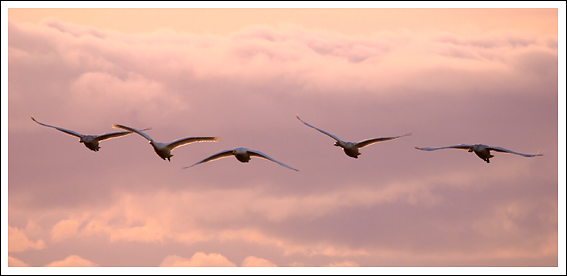| Birds and Windfarms - The flight of the whooper swans |
(1420) |
| SWANS AND GEESE ARE ALSO VICTIMS OF THE WINDFARMS, AS MOST BIRDS ARE |
Loch Awe is set in a beautiful area of Scotland where one will find a remarkable blend of amenity and wilderness. Here the traveller will be able to watch ospreys and golden eagles in their natural surroundings, and marvel at the majestic flight of the whooper swans.
--Mark Duchamp-- |

TESTIMONY by a local resident
On the 1st of February 2003 my wife and I were standing high up on the hillside above and overlooking Liever Island on Loch Awe. It was approximately 2.30pm on a clear day with a fairly strong wind blowing from the South West.
Earlier we had watched a group of five adult Whooper Swans feeding in the bay on the west side of the Island.
As we looked out across the Loch the Swans flew up into the wind and made their way in the direction of the seacoast to the West. I watched with interest as they rose steadily into the full force of the wind. The group tightened into a more compact formation as they fought to make headway, from our viewpoint it was easy to see that at times they were almost stationary in the airflow. They repeatedly slid into a skein formation and back into a group as they tried to slipstream each other along. The battle was too much for them so they flew lower and made their way by flying across the wind to the lee of the hill to the South. They gradually quartered up the hillside in the slower air, by now they had been flying for at least five minutes.
When they reached the crest they met the full force of the air stream directed upwards by the hill, I expected them to give up and come back to the Loch, but instead they fought on, flying ever higher, facing directly into the gale. Then, when I thought that they must give up the battle as they were making no forward progress, they turned their heads to the South and allowed the wind to carry them sideways at tremendous speed for several miles. They skimmed the length of the valley ridge plateau from it’s western corner almost to it’s eastern edge before they disappeared from view, no doubt making their way down the other side of the ridge to the quieter waters of Loch Fyne.
I remember saying to my wife, “Thank God there isn’t a Wind Farm on that ridge”.
Karl Pipes
Yet a number of windfarms will be built on such ridges near the lake. This is how ineptly Scottish Natural Heritage is accomplishing its mission.
--Mark Duchamp--
More information on birds and windfarms here: The negative effects of windfarms: links to papers published by Mark Duchamp
| Insertado
por: Mark Duchamp (22/03/2004) |
| Fuente/Autor:
Karl Pipes |

Valoración
Comentarios
|
